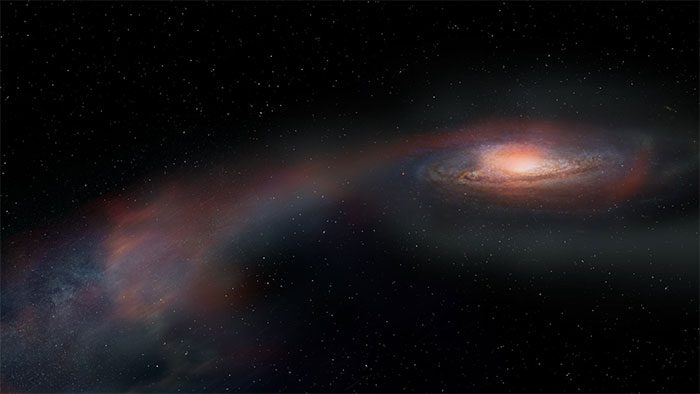Two powerful telescopes, ALMA and Hubble, captured a spectacular moment when a massive galaxy tore apart star-forming gas from another galaxy—an action that the Earth-containing monster may have performed approximately 16 times.
According to Sci-News, the special image depicts galaxy SDSS J144845.91+101010.5, which was formed when the universe was nearly half its current age.
Interestingly, SDSS J144845.91+101010.5 is not in a normal state; it is in a phase carrying a long tail of light, which is part of the unfortunate body of another galaxy.

Graphic representation of the galaxy that just cannibalized its kin – (Image: ALMA / ESO / NAOJ / NRAO / S. Dagnello, NRAO, AUI & NSF).
The research team, led by astronomer Justin Spilker from Texas A&M University, analyzed data from the giant ALMA telescope array located in the desert of Chile and NASA/ESA’s Hubble Space Telescope to discover SDSS J144845.91+101010.5.
This massive galaxy recently encountered a smaller galaxy and is nearly finished merging the smaller galaxy into its gigantic body.
ALMA and Hubble data reveal that the tail carried by this ancient galaxy contains nearly half of the cold star-forming gas of the entire system, equivalent to 10 billion times the mass of the Sun.
According to Dr. Spilker, the massive galaxy had previously abruptly stopped forming stars about 70 million light-years ago after a period of star formation described as a “burst.”
However, the encounter seems to be a stroke of luck for the giant, as it siphoned abundant star-forming gas from the smaller galaxy, which could help the entire galaxy escape its “zombie” state and continue to thrive.
This precious moment provided additional data on how a galaxy can deplete its energy and then be replenished, as well as how a massive galaxy can evolve, although it still does not explain the larger puzzle of why a galaxy suddenly stops forming stars.
The study was recently published in the scientific journal Astrophysical Journal Letters.
Our Earth-containing Milky Way galaxy is an example of a galaxy that is still actively forming stars. The Milky Way is also one of the “monster-sized” galaxies in the universe, a “winner” in galaxy collisions.
Previous studies have shown that throughout its history, this Earth-containing monster has consumed at least 16 smaller galaxies, which may explain why it continues to be a vigorous star-forming galaxy.


















































